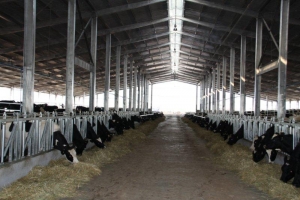Housing and Construction
Does Feed Space Allowance Impact Performance?

There’s no evidence that reducing feed space allowances, when feeding an ad-lib ration, had a detrimental effect on dairy cow performance parameters measured. So says Conrad Ferris, from Northern Ireland’s Agri-Food and Biosciences Institute, whose trial examined, purely from an animal production point of view, a space allowance of 20cm per cow.
“That would appear to be adequate,” he told delegates at this year’s British Society of Animal Science’s annual conference, held at Queen’s University, Belfast.
“However, at a feed space allowance of 20cm per cow, we did see practical difficulties in being able to place the full allowance of food for a 24-hour period in front of the space available at the barrier,” he added.
Meeting the higher nutrient requirements of high yielding dairy cows remains a key challenge for dairy producers and while many studies have examined nutritional approaches to achieve increased food intakes, for example increasing the nutrient density of the diet, ‘non nutritional strategies’ may also have an important role in achieving higher intakes.
“As most food consumed by housed cows is consumed at a feed barrier, options for optimising the feed barrier environment is one of these ‘non nutritional strategies’,” said Dr Ferris. “This is particularly important at present in view of rapidly expanding herd sizes on many farms.
“As herds expand, some producers continue to make use of existing feed barriers – reducing the feed space per cow – while others add additional barrier space at considerable cost.
“But there does not appear to be an agreed ‘optimum’ space allowance per cow, with recommendations ranging from 20cm to 100cm per cow. If feed space is inadequate, this may have a detrimental effect on food intake, performance and welfare, and it might be expected that primiparous animals would be particularly affected,” he said, explaining the rationale behind his team’s work.
Forty-two Holstein-Friesian dairy cows were allocated to one of three treatment groups at calving. The three groups were housed in adjacent, but visually isolated, pens of equal size and similar layout, with 16 cubicles per pen. Within each pen cows accessed food via a ‘post and rail’ type feed barrier. Treatments examined comprised three horizontal feed space allowances – 20cm, 40cm and 60 cm/cow.
Cows remained in their experimental groups for an average of 127 days post-calving, with the period from the last cow calved until the end of the experiment being 88 days. And throughout the experiment cows had ad-lib access to a diet comprising grass silage and concentrates. Fresh food was offered at 10.30am each day in the form of a mixed diet.
Group intakes were recorded daily, but were not analysed statistically due to the unreplicated nature of the intake data.
“And we found that average dry matter intakes with the 20cm, 40cm and 60cm/cow treatments were 19.0, 18.7 and 19.3kg/cow/day respectively,” said Dr Ferris. “So feed space allowance had no significant effect on milk yield per cow, milk composition, milk somatic cell count, or on cow liveweight or condition score at the end of the experiment.”






















